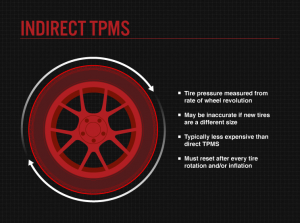The purpose of the tire pressure monitoring system (TPMS) in your vehicle is to warn you that at least one or more tires are significantly under-inflated, possibly creating unsafe driving conditions. The TPMS low tire pressure indicator is a yellow symbol that illuminates on the dashboard instrument panel in the shape of a tire cross-section (that resembles a horseshoe) with an exclamation point.
That indicator light in your vehicle has a history. It’s a history rooted in years of uncertainty about proper tire pressure and many serious car accidents that might have been avoided had drivers known their air pressure was low. Even now, it’s estimated that a substantial number of vehicles hit the road each day with underinflated tires. However, proper tire maintenance with the aid of a TPMS can and does help prevent many serious accidents.
Before this indicator light became commonplace, knowing whether your air pressure had reached unsafe levels meant getting out, crouching down, and using a tire gauge. With few exceptions, this was the only pressure-checking tool ordinary consumers had at their disposal.
Then, in response to a surge in accidents due to underinflated tires, the US government passed the Transportation Recall Enhancement, Accountability, and Documentation (TREAD) Act. One of the outcomes of this legislation is that most vehicles sold in the United States since 2007 include a tire pressure monitoring system of some kind.
Not every TPMS works the same way. The illumination of the low tire pressure indicator represents the final step in the process of either an indirect TPMS or a direct TPMS.
INDIRECT TPMS: WHAT IS INDIRECT TPMS & HOW DOES IT WORK?
An indirect TPMS typically relies on wheel speed sensors that the anti-lock brake system uses. These sensors measure the rate of revolution each wheel is making and can be used by on-board computer systems to compare with each other and to other vehicle operation data such as speed.
Based on the rate of revolution of each wheel, the computer can interpret the relative size of the tires on your vehicle. When a wheel starts spinning faster than expected, the computer calculates that the tire is underinflated and alert the driver accordingly.
So, an indirect tire pressure monitoring system doesn’t actually measure tire pressure. It’s not electronically processing the same kind of measurement you might see with a tire gauge. Instead, an indirect tire pressure monitor simply measures how fast your tires are rotating and sends signals to the computer that will actuate the indicator light when something in the rotation seems amiss.
ADVANTAGES OF INDIRECT TPMS
- Relatively inexpensive compared to a direct TPMS
- Requires less programming/maintenance over the years than a direct TPMS
- Less overall installation maintenance than its direct counterpart
DISADVANTAGES OF INDIRECT TPMS
- May become inaccurate if you purchase a bigger or smaller tire
- May be unreliable when tires are unevenly worn
- Must be reset after properly inflating every tire
- Must be reset after routine tire rotation
DIRECT TPMS: WHAT IS DIRECT TPMS & HOW DOES IT WORK?
Direct TPMS uses pressure monitoring sensors within each tire that monitor specific pressure levels – not just wheel revolution data from the anti-lock brake system.
Sensors in a direct TPMS may even provide tire temperature readings. The direct tire pressure monitoring system sends all of this data to a centralized control module where it’s analyzed, interpreted, and, if tire pressure is lower than it should be, transmitted directly to your dashboard where the indicator light illuminates. A direct tire pressure monitor usually sends all of this data wirelessly. Each sensor has a unique serial number. This is how the system not only distinguishes between itself and systems on other vehicles, but also among pressure readings for each individual tire.
Many manufacturers use proprietary technology for these highly specialized systems, so replacing a TPMS in a way that’s consistent and compatible with your vehicle will require an experienced, knowledgeable technician.
ADVANTAGES OF DIRECT TPMS
- Deliver actual tire pressure readings from inside the tire
- Not prone to inaccuracies because of tire rotations or tire replacements
- Simple resynchronization after tire rotation or tire replacements
- Batteries inside the sensors usually last for about a decade.
- May be included in a vehicle’s spare tire
DISADVANTAGES OF DIRECT TPMS
- More expensive overall than an indirect TPMS
- Though simple, resynchronization may require costly tools.
- Battery rarely serviceable; if the battery is drained, the whole sensor must be changed.
- Proprietary systems make installation, service, and replacement confusing for consumers and auto shops.
- Sensors are susceptible to damage during mounting/demounting
TIRE PRESSURE AND SAFETY
Although the methods may be different, both systems serve the same purpose and activate the same indicator light. Even though a TPMS can deliver accurate alerts when properly maintained, it’s not a replacement for manual air pressure checks, consider it just another item in your car maintenance toolbox.


No comments:
Post a Comment